The Village of Mount Carmel Neighborhood History
The following is our neighborhood’s grand history, about how it came about and why streets are named as they are.
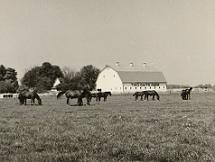
In 1934, Mr. Leo C. McNamara, Sr. was in the road construction business and purchased a 100 acre farm northwest of Carmel. The horse farm, initially acquired as a hobby, was continually added to over the years, eventually consisting of 700 acres. Two Gaits Farm, named for the trotter and pacer gaits of the Standard-bred horse (harness horse), stretched from 136th Street to Greyhound Pass to the north.
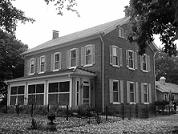
Mr. & Mrs. McNamara lived in the red brick farmhouse, built in 1861, just north of 146th Street and west of Oakridge Road. (It remains standing today) They had one daughter and nine sons. The kids grew up on the farm and helped with the raising of the horses. Many people would take a Sunday drive to the farm to enjoy the horses, as well as the clean, neatly kept barns, well-maintained pastures and miles of freshly painted white fences. The home was sold in the early 1990s. Both a son and a granddaughter, still today, make their home in the Village of Mt. Carmel.
At one time, Two Gaits Farm was internationally known as the largest standard-bred, pacer, breeding farm in the country. The farm was the birthplace of numerous famous horses over the years. In the early 1950’s there were over 500 horses being cared for on the farm.
Brood mares were sent from all over the United States and Canada to be bred with the famous Two Gaits stallions. The south part of the farm, which spread from what is now Bennett Road south to 136th Street, was reserved for outside owned horses exclusively. This was done as a health measure in order to control any disease that an incoming mare might carry.
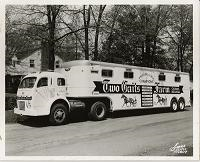
Every year, in late August, the McNamara’s prepared about 50 colts and fillies to sell at the Yearling Sales in Lexington, Kentucky and Harrisburg, Pennsylvania. Horsemen would come from around the country to examine and view these yearlings during the State Fair’s Grand Circuit Race meeting. The van, pictured here, was built in 1950 specifically for moving The Two Gaits Racing Stable, around the country. Mr. Ralph Baldwin was a private driver and trainer for the farms’ Racing Stable of 106 horses in Winter Park, FL.
In the mid 1950s, Mr. McNamara decided to develop a top-notch planned community. He felt that this area could provide a good, farm-type atmosphere in which to raise a family. A complete survey was made of the farm and a noted community development architect laid out a master plan for a new community that would be known as the Village of Mt. Carmel. He developed water and sewer systems for this community, which were the first privately owned facilities of that nature in Hamilton County. (The private water system was still used for the VOMC until 2002.) The reputation of Two Gaits Farm put Carmel on the map, thru the notoriety of the newspapers.
In 1955, Mr. McNamara donated, to the Diocese of Lafayette, a sizable sum of money and 11 acres of land for the building of a church and school. The church, at the corner of 146th and Oakridge Road, was named Our Lady of Mt. Carmel and was completed in 1956. Mr. McNamara died in 1959 but the development continued. In August 1973, the McNamara family, due to a variety of reasons, sold the entire farm to Mr. Ralph Wilfong. He went on to develop Sections 6, 7 and 9 expanding the floor plans from the typical ranch style home common in sections 1-5, to include the Tri-Level and Two Floor plans that are very common in the rest of Mt. Carmel. (Section 8, known as the ‘new’ section, began development in 1995) He took the property north of 146th Street and made a new subdivision. He named it The Village Farms, keeping with Mr. McNamara’s dream of a farm-type community. Mr. Wilfong was a developer by profession, and a lover of horses. He moved into the brick home between Adios Pass and Village Drive North, on 146th street in 1973, and lived there until his death in the mid 1990s. In 2003, a few remaining acres became John Paul Way and section 10 was born.
In the early 1940’s, an excellent ˝ mile clay-training track was built between HARMONY ROAD, and ADIOS PASS. This was removed for the housing development in the late 1970’s and relocated just north of 146th Street until the mid 1990’s, when The Village Farms was developed.
Notable street names
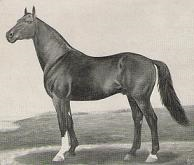
- Bennett Rd. was named after Bishop Bennett who was the first Bishop of the Diocese of Lafayette in Indiana.
- Village Dr. was named to signify the ‘Village’ or tight knit community that Mr. McNamara envisioned for The Village of Mt. Carmel. In the original plans for the neighborhood, developers wanted the layout to resemble the shape of a rosary. After Mr. Wilfong purchased the remaining part of the farm, he abandoned the original masterplan and adjusted it to the present configuration. The main north/south street and Bennett Road and Adios Pass semi-accomplished this.
- Park View Rd. was named after the park surrounding the water tower that used to stand near the corner of Park View Road and Adios Pass. The park sat on 4 acres of land and was used as a central meeting place for the families and friends of village residents. The gatherings became annual traditions for some of the residents of Mt. Carmel. New homes have since been built in that area and a new park developed with a swimming pool and tennis courts.
- Meadowview Ct. was named after Meadow Downs Race Track in Pennsylvania.
- Hamp Ct. was named after a friend of Mr. McNamara’s. They were Directors of the United States Trotting Association (USTA) together where Mr. McNamara was also a founder. His full name was Max Hamp.
- Colby Ct. was named after the pacer stallion, Colby Hanover who produced several champion pacers.
- Dream Ct. was named after the brood mare, Dream, daughter of Knight Dream. Nothing else is known about her.
- Marilyn Ct. was named after, Marilyn, another mare at the farm. Not much is known about her.
- NANSEMOND DRIVE/COURT, NEVELE LANE (Nevele’s Pride) and POPLAR BYRD COURT were named after stallions on farms throughout the country. They were not part of Two Gaits but they did produce fine pacer offspring.
- Haldale Dr. was named after Hal Dale, Two Gaits’ first stud and premier stallion for the farm. He was born to Sire, Abbedale & Dam, Margaret Hal in 1926 in New Ross, Indiana. Mr. McNamara purchase him from the McClintock’s of Frankfort, Ind. He was a pacer, and is known in more recent times, as the “grand daddy” of all the great pacers in the last 45 years. He started a new blood line of pacers, who have gone on to become champions in their own right. He was the sire of Adios, Irish Hal, Kitty Hal, Dale Frost and Hal Senator to name a few. In the beginning his stud fee was $50 but as he produced offspring that won races, his stud fees topped $5,000! He died on October 16, 1955. Hal Dale was an outstanding standardbred Sire and has carved his name in the Harness Horse Halls of Fame, here in Indiana, and in the United States Trotting & Pacing Hall of Fame, in Goshen, New York. He will live on as one of the best pacing stallion in the country.
- Adios Pass was named after Adios, one of the prize offspring of Two Gaits Farm.
- Painter Ct. was named after the pacer stallion, Painter. He produced several above-average pacers, but did not compare to Hal Dale or Adios as a prize stud. Painter was sold to the Castleton Farm of Lexington, Kentucky, when Two Gaits Farm was disbanded.
- Love Ct. and Song Ct. were named after Love Song, a brood mare that produced many champion trotters.
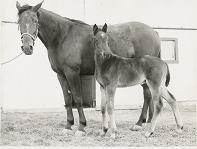
Mr. Leo C. McNamara, Sr., once envisioned Mt. Carmel as a family community with a farm-type atmosphere. The Village of Mount Carmel continues to be a great place to live and raise a family.